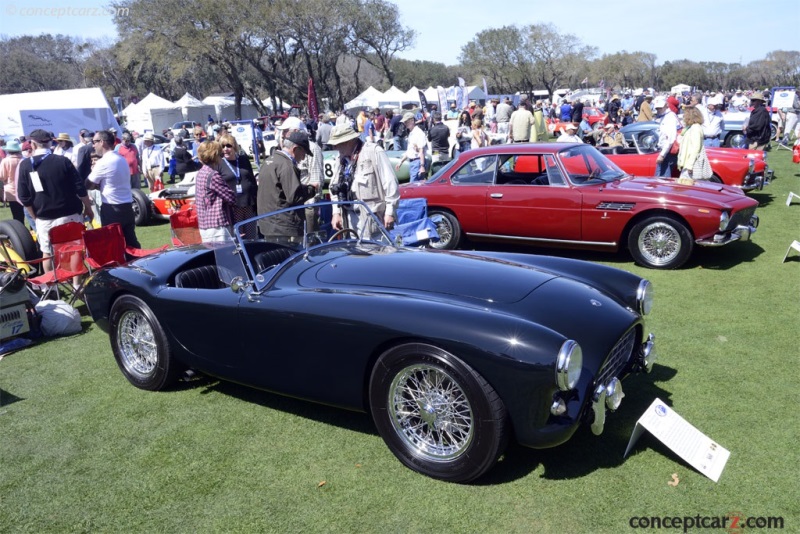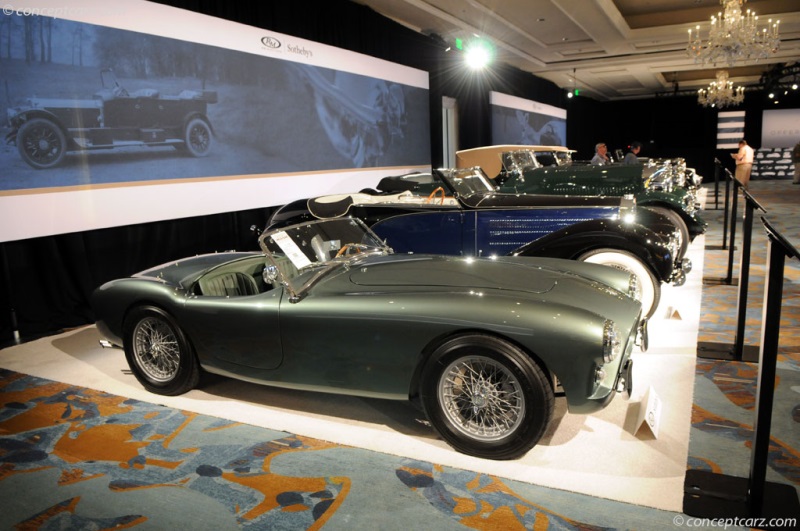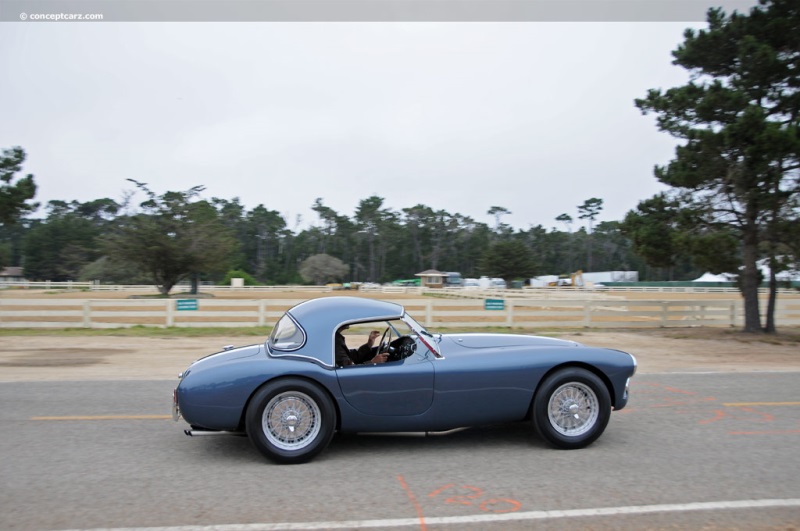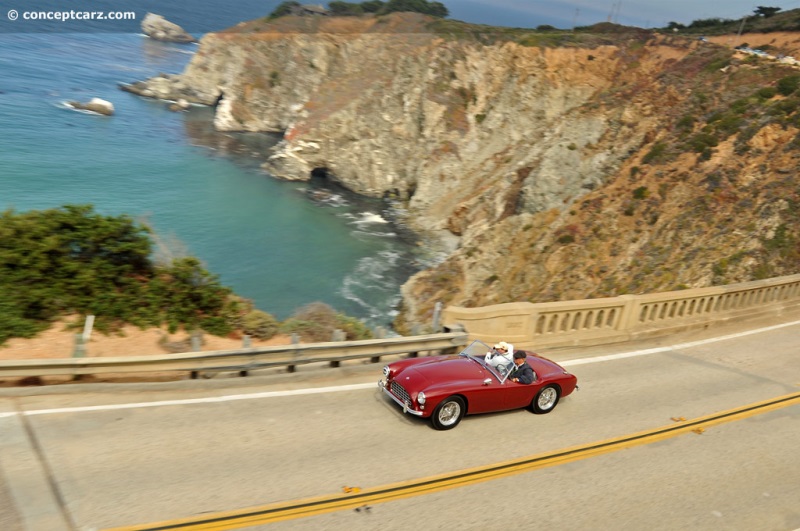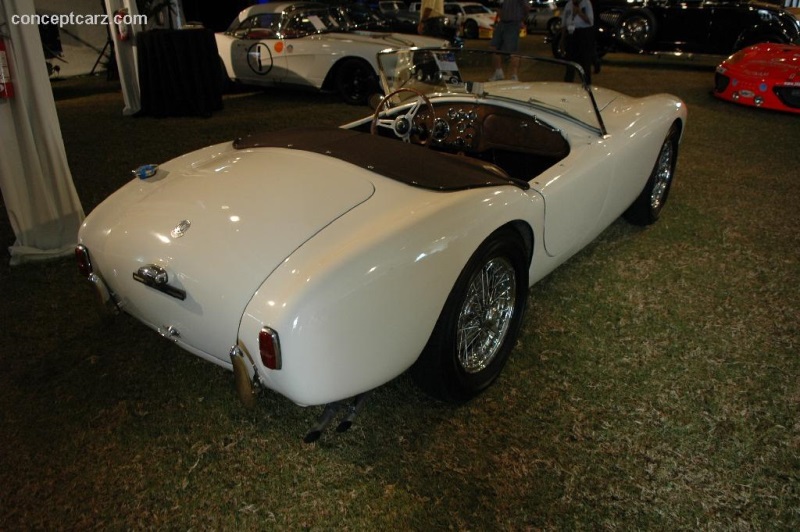History
The Ace was introduced in 1953 at the London Motor Show and was produced beginning in 1954 and continuing through 1963. The vehicle consisted of lightweight tubular chassis with steel boxes in the front and rear which supported a transverse leaf and lower wishbone independent suspension system. The chassis was designed by John Tojeiro. Power was initially provided by a Welleter-designed engine and was mounted in the front of the vehicle but placed back far enough to take advantage of balance. The body and design of the vehicle were inspired by the 2-seater Ferrari 166MM Barchetta (little boat) made by Touring of Milan.
During the first year of production, there were fewer than 60 examples produced. These were all Aces - convertibles. The Aceca, a hardtop variant, debuted in 1954.
Due to the vehicle's lightweight, optimal weight distribution, responsive engine and handling, and stylish appearance, it attracted much attention.
In 1956 the Bristol-engine version was introduced, replacing the Welleter-designed motor. The Bristol 1971 cc, six-cylinder engine was capable of producing 125 horsepower at 5750 rpm and propelling the lightweight car to a top speed of around 180 kph. Production of the Bristol engines ceased around the end of the 1950's and AC began using a British Ford Zephyr engine. It was a heavier engine and produced less power. There were only 47 of these 2.6-liter examples produced from 1961 through 1963.
The vehicles came equipped with front disc brakes, Girling hydraulic shock absorbers, rack-and-pinion steering, and a four-speed manual transmission.
In total, there were around 735 Aces and 326 Acecas produced. The AC Ace was the basis for one of the best-known sports cars of all time, the Shelby Cobra.
By Daniel Vaughan | Aug 2009
During the first year of production, there were fewer than 60 examples produced. These were all Aces - convertibles. The Aceca, a hardtop variant, debuted in 1954.
Due to the vehicle's lightweight, optimal weight distribution, responsive engine and handling, and stylish appearance, it attracted much attention.
In 1956 the Bristol-engine version was introduced, replacing the Welleter-designed motor. The Bristol 1971 cc, six-cylinder engine was capable of producing 125 horsepower at 5750 rpm and propelling the lightweight car to a top speed of around 180 kph. Production of the Bristol engines ceased around the end of the 1950's and AC began using a British Ford Zephyr engine. It was a heavier engine and produced less power. There were only 47 of these 2.6-liter examples produced from 1961 through 1963.
The vehicles came equipped with front disc brakes, Girling hydraulic shock absorbers, rack-and-pinion steering, and a four-speed manual transmission.
In total, there were around 735 Aces and 326 Acecas produced. The AC Ace was the basis for one of the best-known sports cars of all time, the Shelby Cobra.
By Daniel Vaughan | Aug 2009
The oldest British car manufacturer, AC has continuously produced vehicles since 1901 and the marque carries enormous prestige. The AC Aceca, a closed coupe, was unveiled in 1954 in London and only 328 prototypes were ever produced.
Production of the Aceca Coupe commenced in 1955 and Le Mans 1957 was a lucrative one for AC, with an AC Bristol finishing tenth overall. 1958 was an even better year as a special-bodied AC Bristol finished eighth and a standard car ninth. Produced from 1954 until 1963, the similar Bristol-engined Aceca-Bristol was also eventually available in the 1956 model year. Both of these models were hand-built GT vehicles in the British tradition, and both featured ash wood joining steel tubing into their construction. Following the 1953 Aston Martin DB2/4, the Aceca was only the second vehicle to incorporate the hatchback at the rear.
The differences between the Aceca and the Aceca-Briston lay in the engines. Though both were straight-6es, the Aceca shared its 90 hp 2.0 L engine with the lighter AC Ace, and the Aceca-Bristol utilized a 125 hp 'D-Type' 2.0 L unit sourced from Bristol Cars. One was also able to purchase the Aceca-Bristol with a milder 'B-Type' Bristol engine of 105 hp. The Aceca was priced at $5,400 in the U.S. but the Bristol specification added another $1000 to the price tag. A total of 151 Acecas were produced, while 169 Aceca-Bristols were built. Unfortunately, production was halted quite unexpectedly in 1963.
Certain design specifics in the Aceca were taken from the exquisite design work by Pina Farina for the AC Company in the 1940s, these included in the front-end styling. The grille was simple, but the curves were perfectly executed along with the hood and around the headlights. The Aceca had a superbly low weight due to the tubular frame, and aluminum body panels, and aluminum engine block. Other weight-saving features were in the 16' spoked wheels and nearly perfect weight distribution in the fore/aft which also contributed to the exception handling on loose, dirt tracks. The Aceca exhibited its distinctive engineering with the front-wheel disc brakes, articulated rear half-axles, transverse 'de Dion' leaf rear suspension, worm-gear steering, curved windshield, electronic overdrive in 2nd, 3rd, and 4th gear The bucket seats were also very well-designed and encased in leather in true 1950's vintage auto style.
Also very innovative for the time, the AC engine was considered to be 'an engineering marvel', patterned after the powerful Bristol aircraft engine. The engine was an inline 6, aluminum block, overhead cam, double chain drive that was fueled by 3 inline SU downdraft carburetors, that each fed two cylinders. 6 straight-out header pipes were directly opposite and these allowed the combustion gases to enter the cylinder, do one rotation during combustion and exit oppositely, straight-out, without any resistance.
Enthusiasts consider the Aceca to be a great car to drive, though it rides a bit hard, due to the stiff suspension. Cornering and steering were done quite proficiently, but some complained that it tended to oversteer, but it was still 'solid and predictable' handling. Consumers also complained about the inadequate rear mirrors, a heating system not properly suited to colder climates, and inadequate soundproofing above 75 mph.By Jessica Donaldson
Production of the Aceca Coupe commenced in 1955 and Le Mans 1957 was a lucrative one for AC, with an AC Bristol finishing tenth overall. 1958 was an even better year as a special-bodied AC Bristol finished eighth and a standard car ninth. Produced from 1954 until 1963, the similar Bristol-engined Aceca-Bristol was also eventually available in the 1956 model year. Both of these models were hand-built GT vehicles in the British tradition, and both featured ash wood joining steel tubing into their construction. Following the 1953 Aston Martin DB2/4, the Aceca was only the second vehicle to incorporate the hatchback at the rear.
The differences between the Aceca and the Aceca-Briston lay in the engines. Though both were straight-6es, the Aceca shared its 90 hp 2.0 L engine with the lighter AC Ace, and the Aceca-Bristol utilized a 125 hp 'D-Type' 2.0 L unit sourced from Bristol Cars. One was also able to purchase the Aceca-Bristol with a milder 'B-Type' Bristol engine of 105 hp. The Aceca was priced at $5,400 in the U.S. but the Bristol specification added another $1000 to the price tag. A total of 151 Acecas were produced, while 169 Aceca-Bristols were built. Unfortunately, production was halted quite unexpectedly in 1963.
Certain design specifics in the Aceca were taken from the exquisite design work by Pina Farina for the AC Company in the 1940s, these included in the front-end styling. The grille was simple, but the curves were perfectly executed along with the hood and around the headlights. The Aceca had a superbly low weight due to the tubular frame, and aluminum body panels, and aluminum engine block. Other weight-saving features were in the 16' spoked wheels and nearly perfect weight distribution in the fore/aft which also contributed to the exception handling on loose, dirt tracks. The Aceca exhibited its distinctive engineering with the front-wheel disc brakes, articulated rear half-axles, transverse 'de Dion' leaf rear suspension, worm-gear steering, curved windshield, electronic overdrive in 2nd, 3rd, and 4th gear The bucket seats were also very well-designed and encased in leather in true 1950's vintage auto style.
Also very innovative for the time, the AC engine was considered to be 'an engineering marvel', patterned after the powerful Bristol aircraft engine. The engine was an inline 6, aluminum block, overhead cam, double chain drive that was fueled by 3 inline SU downdraft carburetors, that each fed two cylinders. 6 straight-out header pipes were directly opposite and these allowed the combustion gases to enter the cylinder, do one rotation during combustion and exit oppositely, straight-out, without any resistance.
Enthusiasts consider the Aceca to be a great car to drive, though it rides a bit hard, due to the stiff suspension. Cornering and steering were done quite proficiently, but some complained that it tended to oversteer, but it was still 'solid and predictable' handling. Consumers also complained about the inadequate rear mirrors, a heating system not properly suited to colder climates, and inadequate soundproofing above 75 mph.By Jessica Donaldson
Similarly Sized Vehicles
from 1960
Similarly Priced Vehicles
- Lincoln Continental Mark V ($6,595-$10,235)
- Jaguar MKIX ($6,000-$6,000)
- Alfa Romeo 2000 ($5,030-$5,950)
- Chrysler 300F ($5,410-$5,840)
- Mercedes-Benz 220 Series ($4,283-$8,090)
- Cadillac DeVille ($5,250-$5,500)
- Jaguar XK-150 ($4,500-$5,200)
- Mercedes-Benz 190 SL ($5,030-$5,240)
Average Auction Sale: $254,670
1960 AC Ace Vehicle Profiles
Recent Vehicle Additions
Performance and Specification Comparison
Price Comparison
$5,700 - $6,600
Ace Specification Comparison by Year
Year
Production
Wheelbase
Engine
Prices
Related Automotive News

London Concours to celebrate the great coachbuilder Zagato, with dedicated retrospective this June
Legendary designs from Zagatos past to be displayed at the HAC in the heart of the city
Examples from early cars like the 1958 Abarth 750 Zagato DB, to the ultra-rare Bristol 406 Zagato
Display, presented by DRVN Group, will also feature the cov...

Full Car List Revealed As Countdown To Concours Of Elegance 2019 Begins
Concours of Elegance reveals roll call of the rare and exclusive cars set to appear at Hampton Court in less than a weeks time
The organisers are shining a spotlight on some of the most astonishing cars on display, including a unique 1948 Delahaye...

Pebble Beach Concours Hosts Premier Ferrari Celebration
Concurrent Ferrari Concours to be held on First Fairway of Pebble Beach Golf Links
PEBBLE BEACH, Calif. (June 13, 2017) — The first Ferrari-badged automobile, a 125 Sport with a 1.5-liter V12 engine, took to the open road in the spring...

Amelia Island Concours : Best in Show
The 21st Amelia Island Concours dElegance showcased over 250 vehicles which bravely ventured onto the show field under weather reports that threatened heavy downpours. In an effort to avoid the inevitable rain, the awards ceremony was truncated and...

FIRST 25TH ANNIVERSARY PANOZ ESPERANTE SPYDER DEBUTS AT STANDING-ROOM ONLY CELEBRATION
Panoz LLC also officially dedicates its new 10,000-sq.-ft. exhibition featuring interactive displays showcasing the storied Panoz sports car and racing history
Hoschton, Ga., April 04, 2014–Hundreds of Panoz fans, followers and owners...


























